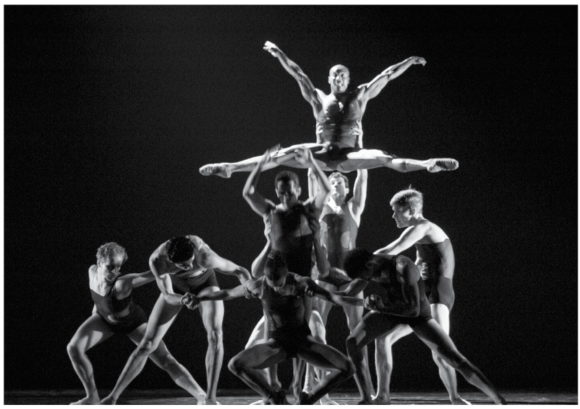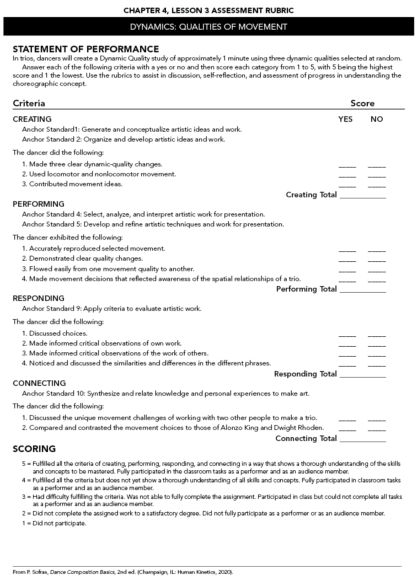Dynamics: Qualities of Movement
This is an excerpt from Dance Composition Basics 2nd Edition With Web Resource by Pamela Anderson Sofras.
Vocabulary
collapsed
dynamic
qualities
dynamics
energy
percussive
suspended
sustained
swinging
vibratory

Uri Sands, the Impulse, is suspended high above the ground after executing a strong percussive jump. The other dancers collapse and sink under him in curved shapes.
© Rolland Elliott
Introductory Statement
The use of different gradations of energy to perform a movement is often described as adding dynamic quality to movement. Specifically, in dance we identify six dynamic qualities: sustained, percussive, swinging, suspended, collapsed, and vibratory.
Sustained = slow, smooth, continuous, even
Percussive = sudden, sharp, choppy, jagged
Swinging = sway, to and fro, pendulum, undercurve
Suspended = stillness, balance, high point
Collapsed = fall, release, relax
Vibratory = shake, tremble, wiggle
Warm-Up and Quality Definitions
Example: Chapter 4, Lesson 3A: Describing a Quality
Alonzo King wanted specific dynamic qualities expressed in movement while choreographing Dreamer. In this example, watch King describe and demonstrate a percussive movement phrase and the dancers show percussiveness in their bodies.
Warm up by moving within each quality:
Swinging (using legs, then arms, then whole body)
Collapsed (swing a leg up, then collapse the body over it; repeat, alternating legs)
Sustained (melt gradually all the way to the floor until finishing in a stretched shape)
Percussive (rise quickly and begin a rhythmic step-clap-stamp phrase)
Suspended (rise to relevé on both feet and allow arms to follow; find a point of balance, balance on one foot)
Vibratory (begin a soft beating of the feet on the floor and allow the vibration to move up through the body like a volcano until it erupts out through the fingers)
Structured Improvisations
Improvisation 1: Moving Energy
Using a simple walk, explore moving through space using the dynamic qualities (see list). Discuss how the walk changes when a specific dynamic motivates the movement. How does the tempo alter with each quality? Which qualities can be performed with light energy? Which ones require strength?
Sample Locomotor and Nonlocomotor Sequence
Swinging legs with forward steps
Sustained arm stretch
Percussive jumps
Vibratory beating
Collapsing low walk
Suspended breathing
Example: Chapter 4, Lesson 3B: Sustained Movement
In this excerpt, Alonzo King works with dancer Amy Earnest to create slow, sustained movement for a section of Dreamer.
Improvisation 2: Sharing Qualities
- Divide into two groups. Half will dance, half will be the audience. One member of the audience will call out a dynamic quality. The dancers will move in general space in the quality that is called out. Continue in one quality until another is called out randomly. Call out in unexpected ways, slowly and quickly. Explore each quality with both nonlocomotor and locomotor movement.
- Exchange roles until everyone has improvised movement phrases in each quality, quickly changing qualities as they are called out.
- Discuss feelings or emotions that are implied by the different movement qualities and list them on a chart (an example follows).
Movement Qualities
Swinging legs—regularity, evenness
Sustained, stretched arms—laziness, calm
Percussive jumps—happiness, joy, excitement
Vibratory beating—anger, resentment
Collapsing walks—defeat, failure, grief
Suspended breath—anticipation, surprise
Problem Solving
- In a hat, place slips of paper with one dynamic quality written on each piece. Draw one slip of paper from the hat and find two other partners to make a trio. Together look at the three slips of paper. The problem is to create a Dynamic Quality study using only the three qualities selected. The challenge is to find a way to transition between the qualities in a convincing way so that the study is cohesive. The study should be at least 1 minute long. The study should have a clear beginning and ending shape and use both locomotor and nonlocomotor movements.
- Perform the Dynamic Quality studies for each other. Audience members should identify the dynamic qualities chosen. Discuss how it feels to spend a specific amount of time in only one movement quality. Do we do this in natural movement?
Discussion Questions
- In your own words, define energy. Find your own definitions for each of the dynamic qualities.
- When might you move naturally in a percussive way?
- Do emotional states affect how we use energy in movement?
- List different action words that could describe each of the six qualities.

More Excerpts From Dance Composition Basics 2nd Edition With Web Resource
SHOP

Get the latest insights with regular newsletters, plus periodic product information and special insider offers.
JOIN NOW
Latest Posts
- Using double inclinometers to assess cervical flexion
- Trunk flexion manual muscle testing
- Using a goniometer to assess shoulder horizontal adduction
- Assessing shoulder flexion with manual muscle testing
- Sample mental health lesson plan of a skills-based approach
- Sample assessment worksheet for the skill of accessing valid and reliable resources


